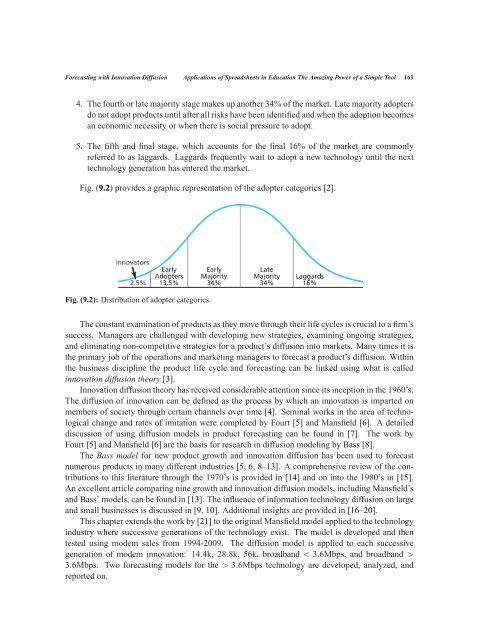chapter 3 - Bentham Science
chapter 3 - Bentham Science
chapter 3 - Bentham Science
You also want an ePaper? Increase the reach of your titles
YUMPU automatically turns print PDFs into web optimized ePapers that Google loves.
Forecasting with Innovation Diffusion Applications of Spreadsheets in Education The Amazing Power of a Simple Tool 161<br />
4. The fourth or late majority stage makes up another 34% of the market. Late majority adopters<br />
do not adopt products until after all risks have been identified and when the adoption becomes<br />
an economic necessity or when there is social pressure to adopt.<br />
5. The fifth and final stage, which accounts for the final 16% of the market are commonly<br />
referred to as laggards. Laggards frequently wait to adopt a new technology until the next<br />
technology generation has entered the market.<br />
Fig. (9.2) provides a graphic representation of the adopter categories [2].<br />
Fig. (9.2): Distribution of adopter categories.<br />
The constant examination of products as they move through their life cycles is crucial to a firm’s<br />
success. Managers are challenged with developing new strategies, examining ongoing strategies,<br />
and eliminating non-competitive strategies for a product’s diffusion into markets. Many times it is<br />
the primary job of the operations and marketing managers to forecast a product’s diffusion. Within<br />
the business discipline the product life cycle and forecasting can be linked using what is called<br />
innovation diffusion theory [3].<br />
Innovation diffusion theory has received considerable attention since its inception in the 1960’s.<br />
The diffusion of innovation can be defined as the process by which an innovation is imparted on<br />
members of society through certain channels over time [4]. Seminal works in the area of technological<br />
change and rates of imitation were completed by Fourt [5] and Mansfield [6]. A detailed<br />
discussion of using diffusion models in product forecasting can be found in [7]. The work by<br />
Fourt [5] and Mansfield [6] are the basis for research in diffusion modeling by Bass [8].<br />
The Bass model for new product growth and innovation diffusion has been used to forecast<br />
numerous products in many different industries [5, 6, 8–13]. A comprehensive review of the contributions<br />
to this literature through the 1970’s is provided in [14] and on into the 1980’s in [15].<br />
An excellent article comparing nine growth and innovation diffusion models, including Mansfield’s<br />
and Bass’ models, can be found in [13]. The influence of information technology diffusion on large<br />
and small businesses is discussed in [9, 10]. Additional insights are provided in [16–20].<br />
This <strong>chapter</strong> extends the work by [21] to the original Mansfield model applied to the technology<br />
industry where successive generations of the technology exist. The model is developed and then<br />
tested using modem sales from 1994-2009. The diffusion model is applied to each successive<br />
generation of modem innovation: 14.4k, 28.8k, 56k, broadband < 3.6Mbps, and broadband ><br />
3.6Mbps. Two forecasting models for the > 3.6Mbps technology are developed, analyzed, and<br />
reported on.

















